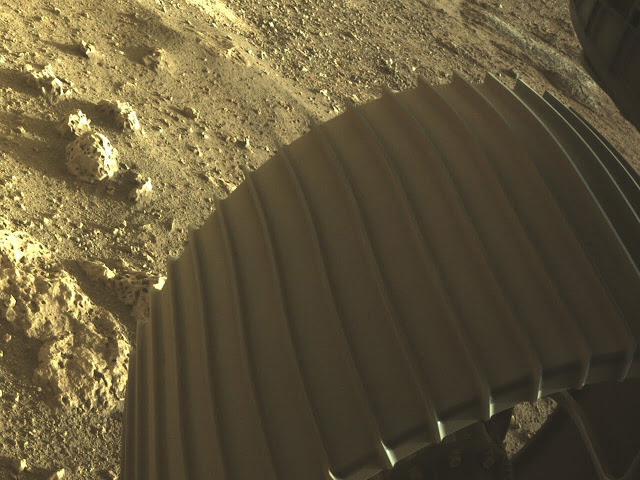Perseverance Mars rover successfully touches down on Mars
 |
This
high-resolution still image is part of a video taken by several cameras as
NASA’s Perseverance rover touched down on Mars on Feb. 18, 2021. A camera
aboard the descent stage captured this shot. A key objective for Perseverance’s
mission on Mars is astrobiology, including the search for signs of ancient
microbial life. The rover will characterize the planet’s geology and past
climate, pave the way for human exploration of the Red Planet, and be the first
mission to collect and cache Martian rock and regolith (broken rock and dust).
Subsequent NASA missions, in cooperation with ESA (the European Space Agency),
would send spacecraft to Mars to collect these cached samples from the surface
and return them to Earth for in-depth analysis. The Mars 2020 mission is part
of a larger program that includes missions to the Moon as a way to prepare for
human exploration of the Red Planet. JPL, which is managed for NASA by Caltech
in Pasadena, California, built and manages operations of the Perseverance and
Curiosity rovers. Credits:
NASA/JPL-Caltech
It is over, the seven minutes of terror were a success
for NASA or rather it is starting, landing the Perseverance rover was just the beginning
of what could be a very fruitful mission on the red planet, in search for life
and perhaps the origins of this.
The new tenant on the fourth rock from the sun
touched down last Thursday 18th of February on Mars at 8:55 UTC or at
3:55 p.m. EST in Southern California were NASA’s Jet Propulsion Laboratory is
located. The journey took 203 day after travelling 472 million kilometres.
It is over, the seven minutes of terror were a success
for NASA or rather it is starting, landing the Perseverance rover was just the beginning
of what could be a very fruitful mission on the red planet, in search for life
and perhaps the origins of this.
 |
This is the
first high-resolution, color image to be sent back by the Hazard Cameras
(Hazcams) on the underside of NASA’s Perseverance Mars rover after its landing
on Feb. 18, 2021. Credits: NASA/JPL-Caltech |
 |
This
high-resolution image shows one of the six wheels aboard NASA’s Perseverance
Mars rover, which landed on Feb. 18, 2021. The image was taken by one of
Perseverance’s color Hazard Cameras (Hazcams). NASA/JPL-Caltech |
This is up today the largest and most advanced
rover NASA has sent to another world, which is packed with ground-breaking
technology, and it is only the first step in the effort to collect Mars samples
and return them to Earth.
Perseverance is about the size of a car, weighting
1,026 kilograms, this geologist and astrobiologist robot will undergo several
weeks of testing before it begins its two-year science investigation of Mars’ Jezero Crater, and ancient
lakebed and river delta. There, the new robot will characterize the region’s
geology and past climate, been astrobiology a fundamental part of its mission,
including the search for signs of ancient microbial life.
 |
Ancient Jezero
crater (artist concept). This illustration shows Jezero Crater — the landing
site of the Mars 2020 Perseverance rover — as it may have looked billions of
years go on Mars, when it was a lake. An inlet and outlet are also visible on
either side of the lake. A key objective for Perseverance's mission on Mars is
astrobiology, including the search for signs of ancient microbial life. The
rover will characterize the planet's geology and past climate, pave the way for
human exploration of the Red Planet, and be the first mission to collect and
cache Martian rock and regolith (broken rock and dust). Subsequent missions,
currently under consideration by NASA in cooperation with the European Space
Agency, would send spacecraft to Mars to collect these cached samples from the
surface and return them to Earth for in-depth analysis.. Credits:
NASA/JPL-Caltech
While the rover will investigate the rock and
sediment of Jezero’s ancient lakebed and river delta to characterize the
region’s geology and past climate, a fundamental part of its mission is
astrobiology, including the search for signs of ancient microbial life. To that
end, the Mars Sample
Return campaign, being planned by NASA and ESA (European Space Agency),
will allow scientists on Earth to study samples collected by Perseverance to
search for definitive signs of past life using instruments too large and
complex to send to the Red Planet.
Now NASA has released the first images of the descent from the sky-crane camera and of the surface of Mars where it landed, this time NASA equipped the spacecraft with a record 25 cameras and 2 microphones, many of them were switch on during Thursday's descent.
According to NASA officials, the vehicle is healthy, having landed on a flat, safe surface and just 2 kilometres away from the river delta where once water awash its shores 3 billion to 4 billion years ago, scientists consider this are the most likely place to find rocks with evidence of past microscopic life.









